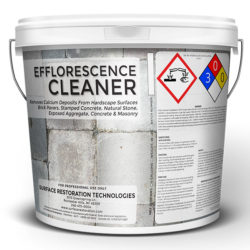Efflorescence Cleaner
Works On All Types Of Exterior Surfaces
Efflorescence Cleaner is a safe, acid based cleaner formulated specifically for use on brick pavers, stamped concrete, concrete, exposed aggregate, stone, brick, masonry, block and retaining walls. It quickly, safely and easily removes white mineral deposits efflorescence that form naturally on the surface. It penetrates deep without damaging the surface. It brightens up the color, cleans evenly and allows a protective sealer to better penetrate the surface.
Safely Removes Efflorescence Deposits
The cleaning power allows deposits and residue to be quickly and easily rinsed away using a pressure washer. The product is suitable for both horizontal and vertical surfaces and is biodegradable and phosphate free. It does not contain muriatic acid, which can damage & etch the surface. Multiple applications may be required to safely remove stubborn efflorescence.
Proper Preparation For Sealing Exterior Surfaces
When it comes to sealing, efflorescence removal is a mandatory step! This is for several reasons. It’s important to remove any efflorescence from the surface because sealing over efflorescence will trap it on the surface so it cannot be removed without complete removal of the sealer. It will also remove stains, dirt, and debris that will ultimately affect the integrity of the sealer if they get trapped below the sealer. The sealer will be able to achieve deeper penetration into clean pores and form a stronger bond with the surface.
Efflorescence Should Be Removed To Avoid Damage
In French, the efflorescence definition means, “to flower out.” If you fail to control efflorescence properly, the issue can spread rapidly out of control.
It can be indicative of a moisture issue that could potentially damage the structure. When migrating water reaches a building material’s surface, evaporation will occur. After the water evaporates, salt is left behind, but water absorption and wicking continue. This creates a high salt concentration, leading to osmosis. During osmosis, water moves toward salt to reduce its concentration, causing large hydrostatic pressures within the porous building material. As a result, these pressures can damage or destroy the material by causing cracking, flaking or falling apart. Osmosis also may result in spalling & separation of the building material due to hydrostatic pressure within.

